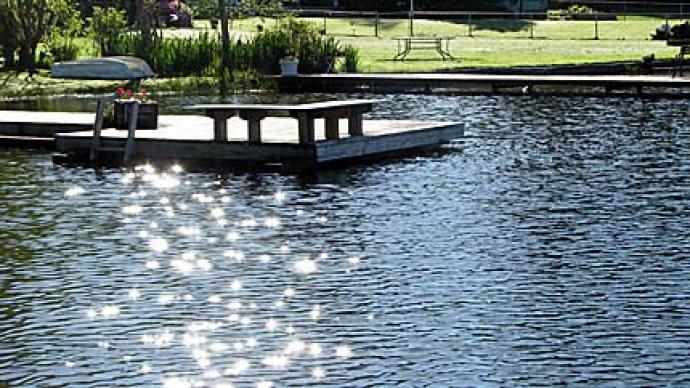
It's bad enough keeping track of all the things we see, much less the things we can't. Yet, in bass fishing, sometimes the invisible is more important than the visible. Included in the former is chemistry, which, at times, can have profound effects on bass health, location, and hence your fishing success. Topping the list of important water parameters is pH.
Technically, pH is the negative log molar concentration of hydronium ions in water. In more down-to-earth terms, pH is a measure of water's acidity or basicity. It is measured on a scale 1-14 with the middle ground, pH 7, considered neutral; pHs less than 7 are acidic, those greater than 7 are basic. The greater the numerical distance from neutrality, the more acidic or basic is the water. A pH of 1 is extremely acidic; 14 is extremely basic.
Unfortunately, the simplicity of the pH scale is somewhat misleading. Most folks tend to think that each unit change in pH is equal. If this were so, then a 2- unit change in pH would equal twice the amount of acid/base difference as that of a 1-unit change. Thus, it would take twice as much acid to drop from pH 7 to 5 as that needed to drop from pH 7 to 6.
However, pH is actually an exponential scale. Every unit change in pH equals a 10-fold increase or decrease in acidity (or basicity). Thus, dropping from pH 7 to 6 is a 10-fold increase in acidity. However, dropping further to pH 5 is another 10-fold increase, or a 100-fold increase (10 x 10 = 100) in acidity from pH 7. For this reason, even minor deviations in pH around the more extreme values constitute much greater changes in acidity (or basicity) than seemingly major changes around the neutral mark. For example, merely dropping from pH 3.1 to 3.0 equals an increase in acidity more than 238 times greater than dropping from pH 7 to 6.
Natural waters vary tremendously in pH, ranging from about 3.2 in peat bogs to greater than 10 in some alkaline desert pools. They also vary considerably in their susceptibility to pH changes due in part to how much buffering capacity the water carries in the form of inorganic salts. These salts rapidly absorb any excess acids and bases, preventing the pH from falling or rising. "Hard water", which carries a heavy salt load, keeps a relatively constant pH. In contrast, "soft water" carries little salt, has little buffering capacity, and changes pH easily.
Bass cannot live throughout the entire natural pH range but have been found in a remarkably diverse spread of acid/alkaline habitats. Healthy populations of Florida bass have been found as low as pH 4.3 in some acidic lakes. I have no information about the upper pH limits of bass, but I suspect it lies somewhere in the range of 8.7 to 9.2.
Bass can tolerate such a wide pH range largely because of their ability to regulate their internal pH. Unlike a bass' body temperature that cannot be regulated physiologically but depends strictly on the ambient temperature, internal pH can be maintained at a constant level over an appreciable range of environmental pH. Bass accomplish this by continually adjusting the relative alkalinity (the ratio between acids and bases) of their blood and tissue fluids. Adjustments are made by expelling excess acids and selective ions in the urine and by controlling the rate of breathing (increasing the ventilation rate removes excess carbon dioxide from the blood, thereby raising blood pH.)
But bass have their limits. Regulating internal pH is energetically costly, and there is only so much physiological capacity available for tolerating hostile pHs. If it stays too long in a highly basic or acidic environment a bass will eventually lose control of its internal chemistry. Bass suffering from sublethal pH stress will suspend many of their normal activities, including feeding. Prolonged exposure to lethal pH levels will ultimately result in death.
Obviously, then, it makes sense for bass to stay at pH levels they can physiologically handle. In other words, if they want to avoid stress and possible death, bass need to behaviorally regulate their pH exposure much like they do with temperature. Recent research has shown that bass acclimated to pH 7 avoid contact with acidic water in favor of moderately basic water. It is not known if bass avoid highly basic water, but it seems reasonable to assume that they would at some point.
If natural waters maintained a uniform pH over space and time, then bass pH preferences would be irrelevant. Some waters might be acidic, others basic, and still others neutral. But if they all stayed uniform, then the only issue would be whether bass could tolerate that pH present in any particular body of water. The bass would have no available choices from which to choose.
However, natural waters are rarely, if ever, uniform in pH. Decaying plants frequently produce acidic compounds that drive down the pH of overlying waters. Thus, bottom waters generally run lower in pH than surface waters. On the other hand, photosynthesis by algae, aquatic plants, and phytoplankton will drive the local pH up. Chemical pollutants can raise or lower pH depending on the specific nature of the pollutant. Some soils are acidic. Others are basic. Soil run-offs, therefore, can significantly alter the pH of feeder creeks and those areas where they empty into the main lake or stream. Agricultural fertilizers and nutrients are typically basic. Run-offs from farmlands will often raise the pH of recipient waters.
Variances in pH can reach dramatic proportions in the spring due to higher than average rainfalls and snowmelt. Normal rain has a pH around 5.6. Heavy rainfalls can lower surface pH and those areas that receive substantial run-offs. In geographical areas downwind of highly industrialized sectors, fossil fuel exhausts have been known to acidify rain to pH levels of 2.5 and lower. If, instead of rain, the acid is stored in snow, the snowpack essentially serves as a giant acid reservoir. During spring melts, the acid is suddenly released in heavy doses, sometimes with devastating effects.
Given that bass monitor their external pH carefully, it seems bass anglers would be wise to likewise keep tabs on this critical water chemistry parameter. If it matters to the bass, then it should also matter to the bass angler.
At this point you might expect me to heartily recommend your buying a pH meter. Well, not heartily, but maybe I would as long as I can throw in a few words of caution.
Laboratory grade pH meters tend to be spendy items, ranging anywhere from a few hundred to well over a thousand dollars. And, because of their high sensitivity, good pH meters require constant recalibration with standardized buffer solutions to ensure accurate readings. The better ones also come with a temperature knob to allow for temperature compensation. Due to their fragile nature, laboratory grade meters are not well-suited for rough-riding bass boats.
More rugged, but usually less sensitive hand-held units are becoming more popular among those professionals who annually take a lot of field measurements. This includes fish farmers, university labs, and government regulatory agencies. These units lie more in the price range anglers can afford, and there is usually a good selection from which to choose. Any good aquacultural supply house should have them listed. Our own lab has had fairly good luck with Aquatic Ecosystems out of Apopka, Florida (www.aquat-iceco.com), but others can be found on the Internet.
If and when you choose to buy a meter, I strongly suggest getting a model that can be periodically recalibrated with known buffer standards (usually sold separately). In any case, do yourself a favor. Don't even consider buying a $29.95 Mart special that has no means of regular adjustment and uses a pH probe that looks like it came straight from the Disney Store. Without any means of standardizing the meter you are obliged to take the manufacturer's word that your new electronic device reads correctly. And, quite frankly, I wouldn't. Usually, pH meters come with a pretty short cable, about 18-24 inches in most cases. If you can, get a cable long enough to measure pH over a range of depth. Something like a 20-ft cord would be great. That way you get a much more accurate pH profile from the surface on down. Measuring only the surface pH is next to useless. You might as well just ignore the invisible altogether.
Reprinted with permission from Bass West Magazine



